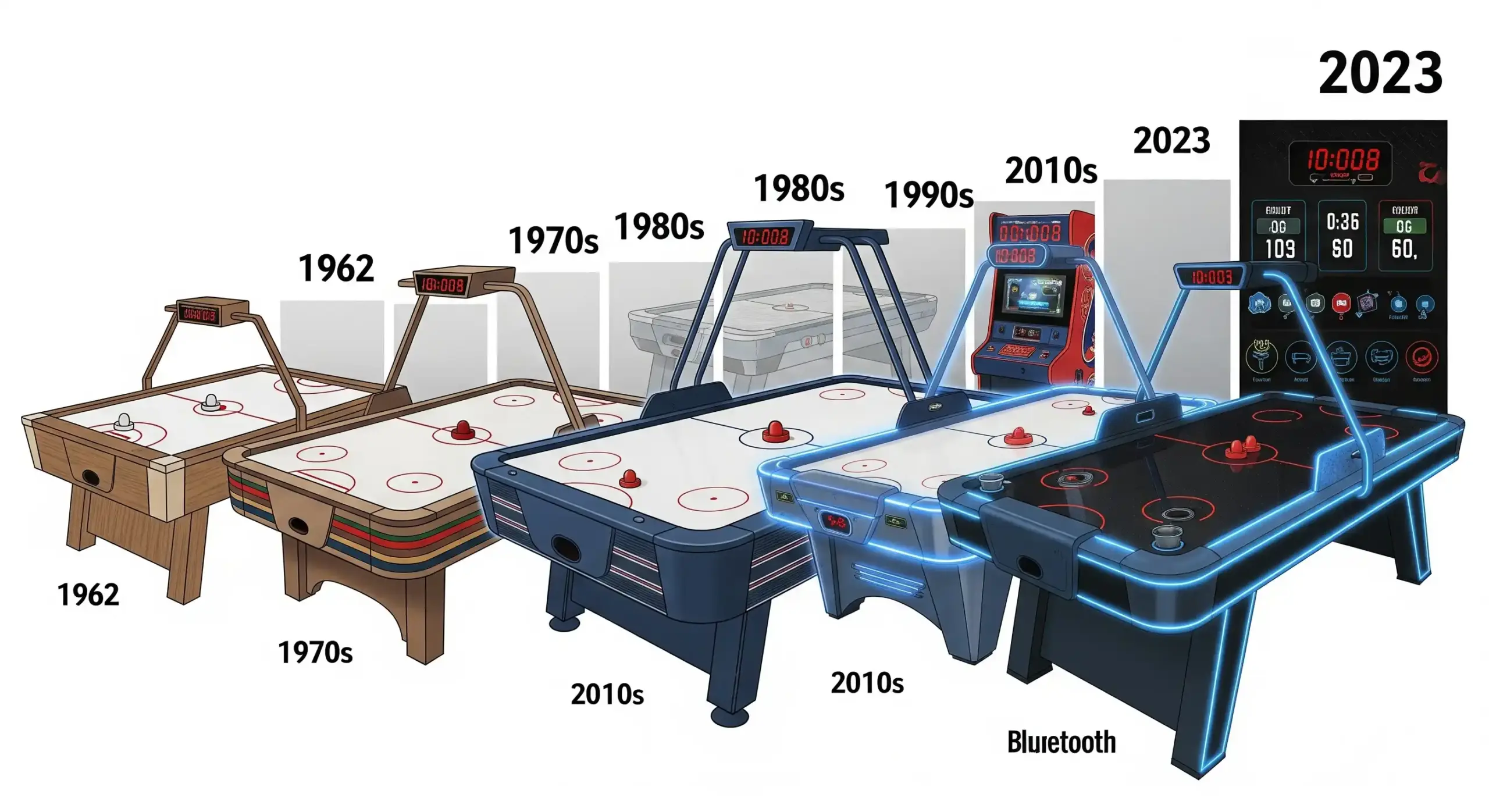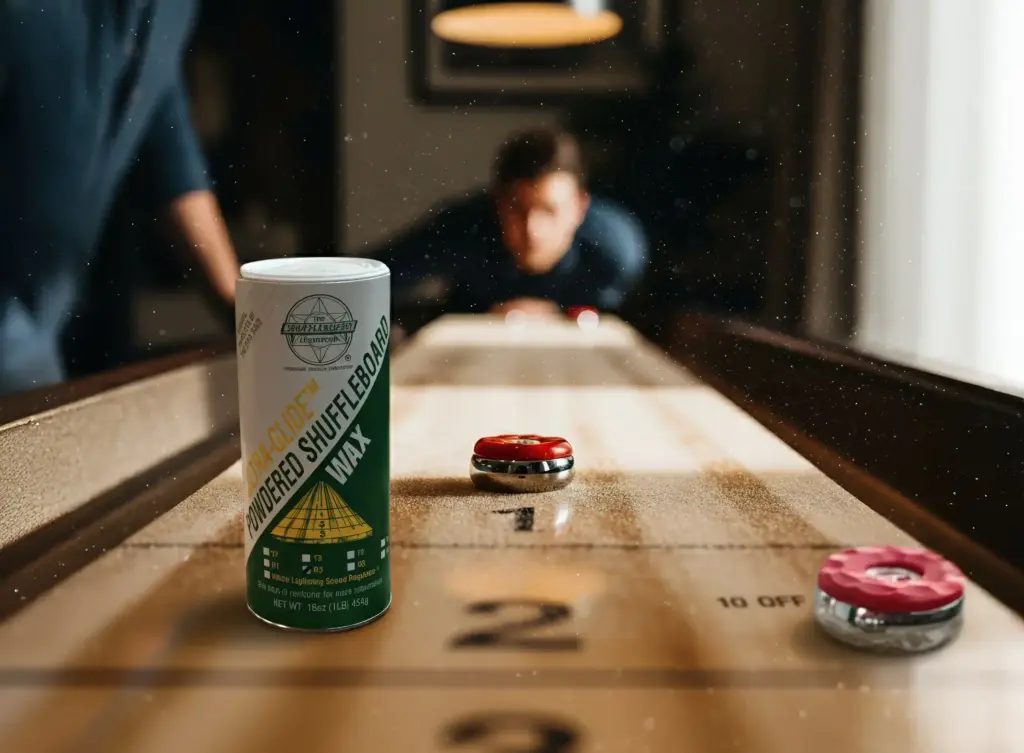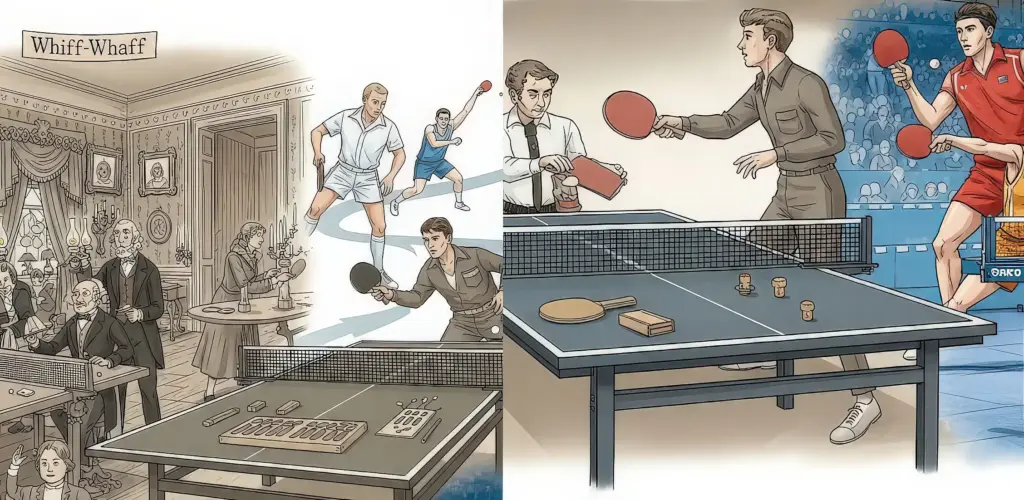Introduction
Have you ever watched an air hockey puck glide effortlessly across the table and wondered how it works? That seemingly magical, frictionless movement is the result of decades of engineering and design evolution. The story of air hockey is more than just the history of a game; it’s a journey from a physics laboratory to the heart of arcade culture, and finally, into the modern family game room. Understanding this evolution reveals not only a fascinating piece of pop culture history but also provides crucial insight into what makes a quality table today.
Key Takeaways
- The history of air hockey begins not in an arcade, but in the engineering labs of Brunswick Billiards, where a team of engineers, led by Bob Lemieux, gamified the concept of a frictionless surface between 1969 and 1972.
- The game exploded in popularity during the 1970s, becoming an arcade staple thanks to Brunswick’s commercial launch and the establishment of the United States Air Hockey Association (USAA) in 1975, which formalized it as a competitive sport.
- The materials and technology have evolved significantly, from early plywood frames and basic blowers to modern tables featuring premium hardwoods, wear-resistant laminates, and powerful, even-airflow systems.
- The modern market has diversified to include not just classic arcade-style tables but also space-saving multi-game tables and durable outdoor models, reflecting the changing needs of homeowners.
- Lessons from the game’s history, particularly regarding blower power and material quality, are essential for anyone looking to purchase a durable, high-performance air hockey table.
The Spark of Invention: More Than Just a Game
The birth of air hockey was an act of creative problem-solving. It wasn’t invented by a single person in a flash of inspiration but was the culmination of a dedicated project by a team of talented engineers who successfully turned a scientific principle into a beloved pastime.
Who Were the Unsung Engineers Behind the Table?
The credit for air hockey belongs to a team of engineers at Brunswick Billiards. The company has a long and storied history of crafting recreational equipment. Between 1969 and 1972, Phil Crossman, Bob Kenrick, and Brad Baldwin began the initial work. However, the project truly took shape under the guidance of Bob Lemieux, an avid ice hockey fan who envisioned an abstracted, fast-paced version of his favorite sport. It was Lemieux’s focus that drove the final design, creating the game we recognize today. You can learn more about Brunswick’s history here.
The Engineering Challenge: Creating a Frictionless Playing Surface
The core challenge was to create a surface where a puck could move with minimal resistance. The team drew inspiration from existing “air tables” used in physics labs to demonstrate motion. The solution was elegant: build a table with a perforated surface and use a blower to pump a continuous, even cushion of air through the holes. This cushion of air lifts the puck just slightly, dramatically reducing friction and allowing for incredible speed.
The First Prototype: What Did the Original 1969 Air Hockey Table Look Like?
The first commercial table, released by Brunswick in 1972, was a marvel of its time. The prototype featured a wood frame and a slick laminate playfield, likely Formica, to ensure a smooth glide. Most impressively, it included electronic scoring from the very beginning. The goals were fitted with photodetectors that could sense when the Lexan polycarbonate puck passed through, automatically updating the score and solidifying the game’s status as a modern arcade attraction.
The Golden Age: How Air Hockey Conquered the Arcade
Once released to the public, air hockey didn’t just find an audience; it created a sensation. It quickly became a pillar of the 1970s arcade scene, defining a new category of one-on-one competitive gaming that was both accessible to beginners and difficult to master.
Brunswick’s Gambit: Taking the Game Public in the 1970s
Brunswick’s decision to trademark the “Air Hockey” name and market the game aggressively paid off immediately. The table’s combination of speed, sound, and skill made it an instant hit in arcades, bars, and bowling alleys across North America. It was a novel experience that stood out among the pinball machines and other mechanical games of the era.
From Niche Invention to Pop Culture Phenomenon
Air hockey became a cultural fixture. Its appeal was enhanced by the iconic “blacklight” aesthetic, pioneered by manufacturers like Dynamo. Tables with UV-coated, fluorescent graphics that glowed under blacklights created an immersive, futuristic experience that was perfect for the dimly lit arcades of the 70s and 80s. The distinctive hum of the blower and the sharp crack of the puck became the soundtrack of countless teenage hangouts.
The Rise of the USAA and the Birth of a Competitive Sport
As the game’s popularity grew, so did the desire for organized competition. In 1975, J. Phillip “Phil” Arnold founded the United States Air-Table Hockey Association (USAA). This was a pivotal moment, transforming air hockey from a casual game into a legitimate sport. The USAA established standardized rules, sanctioned tournaments, and created a framework for crowning world champions, solidifying its place as a game of serious skill.
An Evolution in Craftsmanship: How Tables Have Changed
As a premium retailer, Hallmark Billiards understands that the quality of an air hockey table lies in its construction. The journey from the first plywood models to the high-quality game tables of today is a story of advancing materials and technology, all in the pursuit of a better game.
From Plywood to Premium Materials: The Journey to Modern Durability
The earliest arcade tables were built like tanks, using heavy-duty plywood and solid wood frames to withstand constant use. While effective, these materials were heavy and expensive. Today’s market features a wider range of materials. While many entry-level home tables use Medium-Density Fiberboard (MDF) to reduce cost, premium models from brands like the Brunswick air hockey tables have returned to using solid hardwoods and durable veneers. This evolution provides superior stability, longevity, and a more robust playing experience.
Under the Hood: The Technology of Modern Air Blowers and Puck Design
The heart of any table is its motor. Commercial tables use powerful blowers (around 375 CFM) to ensure a consistent air cushion with no “dead spots.” Many high-end tables now feature dual-motor systems for perfectly even airflow. This is a significant upgrade from the smaller, single blowers found in many budget tables. Puck design has also been refined, with modern tournament pucks made from dense, glass-filled Lexan resin for optimal speed and stability.
A Canadian Game Room Staple: The Rise of Air Hockey in Toronto and the GTA
While born in the USA, air hockey’s appeal quickly crossed the border. The game became a staple in Canadian arcades and home basements throughout the 1980s and 90s. Today, it remains a beloved fixture in game rooms across Toronto and the GTA, a testament to its timeless appeal for families and competitive players alike. Its popularity in Canada mirrors its global growth, cementing its status as an international pastime.
The Modern Air Hockey Table: A Style for Every Home
The modern air hockey market is incredibly diverse, with designs that have evolved far beyond the classic arcade cabinet. This evolution reflects the changing needs of homeowners, who seek furniture that is not only fun but also stylish and versatile. For more ideas, check out our ultimate guide to transforming your billiard and gaming room.
The Classic Arcade Look: Nostalgia in Your Basement
For those who want to recapture the feel of the arcade, many modern tables pay homage to the classic designs. Featuring bright graphics, overhead electronic scoring, and powerful blowers, these tables bring an authentic, high-energy experience into the home. They are perfect for players who prioritize a fast-paced, competitive game.
Multi-Game Tables: The Space-Saving Solution for Today’s Family
Recognizing that space is often a premium, manufacturers now offer innovative multi-game tables. These versatile pieces often combine air hockey, table tennis, and even a dining top into a single footprint. For families in urban areas like Toronto, where every square foot counts, these tables provide maximum entertainment value without dominating a room.
Outdoor and All-Weather Tables: Taking the Fun Outside
A recent innovation is the development of weather-resistant outdoor air hockey tables. Built with durable, waterproof materials, these tables allow the fun to move from the basement to the patio. Models like the Brunswick Bali are designed to withstand the elements, making them a perfect addition to any outdoor entertainment space.
What the History of Air Hockey Teaches Us About Buying a Table Today
The 60-year history of air hockey offers clear lessons for anyone in the market for a table. Understanding the original design goals and how technology has evolved can help you make an informed decision and choose a table that will last for years.
Why a Powerful Motor Matters: Lessons from the Original Design
- The inventors’ primary goal was to create a frictionless surface. This is only possible with a powerful and consistent airflow. When shopping, look for tables with strong motors that eliminate dead spots. A weak motor leads to a slow, frustrating game, defeating the very purpose of air hockey.
Choosing the Right Materials: Does a Hardwood Frame Make a Difference?
- Yes, it absolutely does. The evolution from heavy-duty arcade tables to modern home models shows a clear split in quality. While MDF is common, tables with solid hardwood frames and high-quality laminate surfaces, like those offered by Brunswick, provide far greater stability and durability. This ensures the table remains level and can withstand years of aggressive play.
Finding Your Perfect Table: Let Our Experts Help You Choose
- The journey from a 1960s engineering lab to the modern, multi-functional tables of today is a rich one. With so many styles, materials, and features to consider, choosing the right one can be daunting. Let the experts at Hallmark Billiards use their deep knowledge of this history to help you find the perfect table for your home.
Frequently Asked Questions (FAQ)
Who invented air hockey?
Air hockey was developed by a team of Brunswick Billiards engineers, including Phil Crossman, Bob Kenrick, and Bob Lemieux, between 1969 and 1972. Lemieux is often credited with finalizing the game’s design.
What makes a good air hockey table?
A quality air hockey table has three key features: a powerful, consistent blower motor to eliminate dead spots; a durable, smooth playing surface made of a high-quality laminate; and a sturdy frame, preferably made of solid wood, for stability.
What is the USAA?
The USAA stands for the United States Air-Table Hockey Association. Founded in 1975, it is the official governing body for competitive air hockey, setting tournament rules and standards for professional play.
Conclusion
From a simple demonstration of physics to a global phenomenon, the history of air hockey is a story of innovation and adaptation. The table has evolved from a singular arcade machine into a diverse category of recreational equipment, with models designed for every type of home and player. By understanding this evolution—the importance of the air cushion, the durability of materials, and the spirit of competition—you can better appreciate the game and make an informed choice for your own game room. The legacy of those Brunswick engineers lives on in every fast-paced, exciting match played today.
For expert advice on finding the perfect air hockey table for your home in the Toronto area, contact Hallmark Billiards today.




